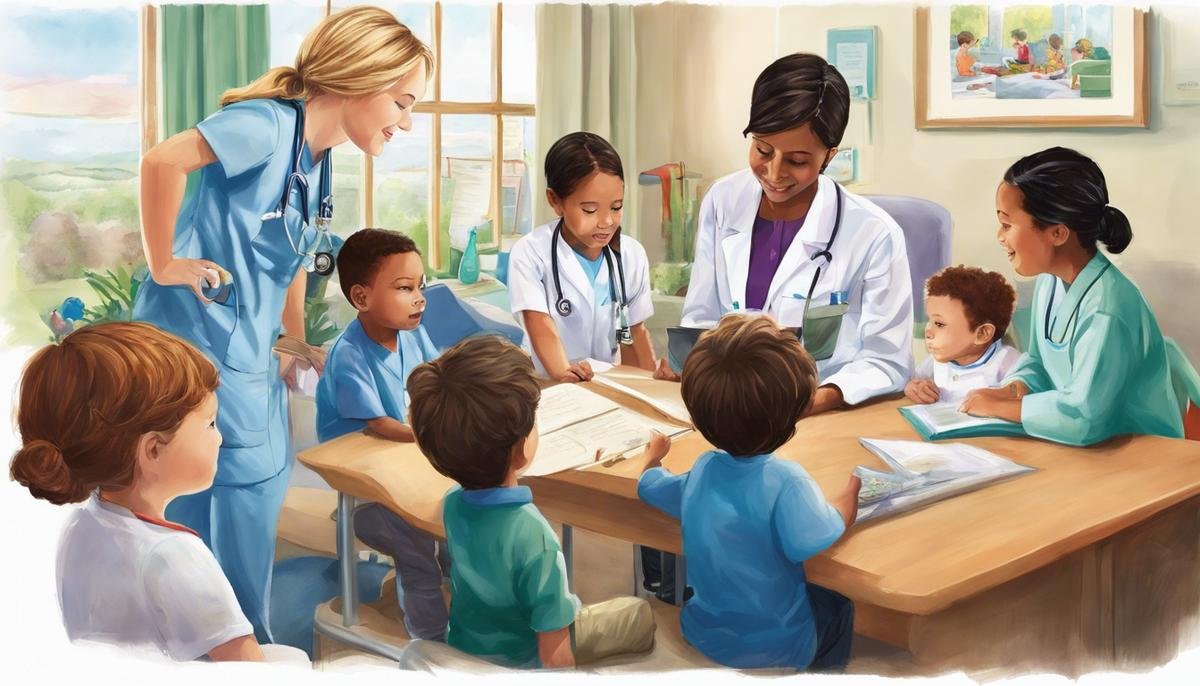
When it comes to the developmental journey of a child, the subtleties in behavior and interaction can often tell a story well before words are formed. For those on the autism spectrum, these subtleties are not merely quirks but signs pointing to a unique neurodiversity that, when recognized early, can pave the way for nurturing support and adaptation. Unfortunately, this recognition does not always come promptly. In the crucial early stages of life, the mirage of typical child development can sometimes render the signs of autism indistinct, leaving parents uncertain and professionals cautious. Raising awareness and increasing understanding of the broad spectrum of autism are the first steps towards timely identification, allowing for interventions that can significantly alter the life trajectory of the child and their family. As awareness grows, so too does the opportunity to initiate positive change at the earliest sign, opening doors to a world where every child’s potential can be realized fully and at the right time.
Recognizing the Early Signs of Autism
Unraveling the Quiet Tapestry: Why Early Signs of Autism Are Often Overlooked
As loving caregivers, we wrap our children in the tapestry of our hopes, dreams, and tender care. In this beautiful complexity, subtle threads can sometimes be overlooked. It’s particularly true when it comes to the early signs of autism. Autism Spectrum Disorder (ASD) is like a quiet pattern woven into the daily life of a child, and recognizing it early can be pivotal for their development. So why are these signs sometimes missed?
First off, let’s acknowledge that children develop at their own pace. What’s considered a “milestone” is more like a range than a precise marker. When little Joey next door started speaking in full sentences at two, and our own bundle of joy is still communicating with a vocabulary of ‘mama’ and ‘more,’ it’s easy for the well-meaning advice to pour in. “They’ll speak when they’re ready,” we often hear, and indeed, many children do. This wide range of ‘normal’ can cause us to overlook delays that might be signs of autism.
Secondly, the subtlety of the early signs of autism plays a huge role. Maybe a child isn’t pointing at objects to show interest by 14 months, or they’re not playing “pretend” games by 18 months. These nuances are easy to miss, especially for first-time parents. After all, who hasn’t been beguiled by the unique personality of their child, attributing their quirks to just that – quirks?
Then there’s the fact that autism presents differently in every child. While one child might have significant language delays, another might have difficulties with social interactions. One might engage in repetitive behaviors, while another could be overly focused on a specific interest. These diverse expressions of autism can confound even the most attentive parents, and healthcare professionals too!
Societal stigmas and lack of awareness contribute to the quiet slipping away of early detection opportunities. We subconsciously resist labels, fearing that they might limit our kids. Nobody wishes their child to face challenges, but addressing needs early can open up avenues for growth and support that benefit children in the long run.
And let’s face it, parenting is an expedition without a compass. Balancing life’s demands while nurturing a family can be overwhelming, making it difficult to pay close attention to developmental concerns amid the whirlwind of everyday life.
Recognizing these reasons for missed early signs is not about assigning blame. It’s about understanding, education, and creating that supportive community where we can share experiences and knowledge.
Knowledge is power, and in the realm of parenting, it’s the power to support our children in all the ways they need us to. Whether a child is neurotypical or neurodiverse like those with autism, each thread of their being contributes to the beautiful tapestry that is our family. Recognizing early signs may just be the key to bringing out the fullest, most vibrant colors of that tapestry for everyone to cherish.

Impact of Delayed Autism Diagnosis
Navigating Uncharted Waters: The Ripple Effects of Delayed Autism Diagnosis
When the journey of autism diagnosis is delayed, the whole family embarks on a voyage through uncharted waters. Imagine a ship that has set sail without a map; that’s often what it feels like for families who encounter late diagnosis of autism in a child. The impact of this delay reaches far beyond initial concerns, affecting every member of the family and the individual with autism in profound ways.
For the individual, a delayed diagnosis can mean missing out on early intervention services, which are vital in addressing developmental challenges. These services can range from speech and occupational therapy to behavioral interventions, all designed to promote better outcomes. Without timely support, individuals might face greater difficulties in communication, social interactions, and education, potentially leading to increased anxiety and frustration.
Families may find themselves on a steep learning curve when a diagnosis comes later in a child’s life. They’ve perhaps grown accustomed to certain patterns and behaviors without the context of autism to guide their understanding. Without this insight, parents can inadvertently reinforce behaviors or miss the opportunity to support their child’s unique learning style.
The absence of a timely diagnosis can also affect siblings. They may struggle with understanding why their brother or sister behaves a certain way, possibly leading to feelings of confusion or resentment. When autism is identified sooner, siblings can become powerful allies in the support network, learning empathy and compassion through their unique family experience.
Socially, the effects of a delayed autism diagnosis can be magnified. Peer relationships for the undiagnosed child can be challenging to navigate. Friends and classmates may not understand why their peer communicates or interacts differently. This gap in understanding can, sadly, lead to bullying or social ostracism.
Financially, families face significant impact when autism is diagnosed later. They may have spent considerable resources on evaluations, therapies, or treatments that do not address the root needs of an autistic child. Moreover, parents might confront job disruptions or reduced income as they seek out appropriate care and support for their child.
Mentally and emotionally, the toll can be immense for the whole family. Parents often grapple with guilt or doubt about what they could have done differently. Although unwarranted, these feelings are natural reactions to the complex emotions stirred up by a delayed diagnosis.
Embracing the highs and lows is part of any family’s dynamic, but when a diagnosis of autism is delayed, those highs and lows can become more pronounced. Early diagnosis equips families with the tools and understanding to celebrate the unique perspectives autism brings, while also addressing the challenges in constructive ways.
By emphasizing the breadth of influence a delayed diagnosis of autism can have, it becomes clear that individuals, families, and communities would benefit from increased awareness, education, and acceptance. Everyone plays a role in supporting early diagnosis and intervention, creating a more inclusive space where every individual has the opportunity to thrive.
Treading these waters may be daunting, but with the right compass of support and information, the voyage can lead to newfound lands of acceptance, understanding, and growth. Let it be a reminder that while the route may be unforeseeable, every family’s journey is marked by resilience and love.

Navigating the Diagnostic Process
Embarking on the Journey to an Autism Diagnosis: Essential Steps for Families
Taking the first step toward an autism diagnosis can be a poignant moment full of mixed emotions. It’s a journey that begins with observation and leads to a deeper understanding of a child’s world. Gather round, folks, because it really does take a village to raise a child, and it sure helps to walk along this path with a bit of guidance.
If you’re noticing behaviors or developmental differences that raise questions, the next crucial step is to consult a pediatrician. Regular checkups often serve as a starting point, but for concerns specific to autism, be prepared with notes or a log of your child’s behavior. Share without hesitation – no detail is too small.
Should there be enough signs to warrant concern, the pediatrician may refer the family to a specialist, such as a developmental pediatrician, child neurologist, or psychologist who has experience with autism spectrum disorders. Bear in mind that specialists often have long waiting lists, so patience is a virtue here. At the same time, advocate fiercely for your little one. If it feels like progress isn’t being made swiftly enough, don’t be shy about seeking a second opinion.
In some cases, state or local early intervention programs might assess toddlers showing signs of developmental delays. These assessments do not provide a formal diagnosis but can be a great avenue for getting support services started. Remember, early intervention can be a game changer!
Formal evaluation for autism often involves a team of experts conducting various tests and observations. These assessments are comprehensive, focusing not just on the possibility of autism but on providing a broad look at a child’s abilities and challenges. The evaluation could include speech and language tests, play-based assessments, parent interviews, and standardized tools such as the Autism Diagnostic Observation Schedule (ADOS).
Documentation and record-keeping from this process benefit everyone involved. Families can use these records to access services, and the specialists involved can ensure that the support provided is tailored to the child’s unique needs.
With a diagnosis in hand, families should explore the wealth of therapies available. Speech and language therapy, occupational therapy, behavior therapy, and social skills classes are a few of the interventions that can make a world of difference. Each treasure trove of resources will be vital to the child’s development.
Always stay proactive—connect with local support groups, parent networks, and organizations dedicated to autism support. The community found in these groups isn’t just about resources; it’s about joining hearts and hands with those navigating similar paths.
And never underestimate the power of educating oneself about insurance and financial assistance programs. Some therapies can be expensive, and understanding coverage options can alleviate stress significantly.
Most importantly, as a family embarks on this journey, the unconditional love for their child becomes the beacon that lights the way. Celebrate small victories, cultivate patience, and keep embracing the moments of joy that this beautiful, unique path brings.
Autism diagnosis might bring challenges, but it also opens doors to understanding and supporting the vibrant spectrum of life shared with our amazing children.

Resources and Support for Families
Navigating the Path Ahead: Vital Resources for Families After an Autism Diagnosis
When a diagnosis of autism comes later than expected, it can initially feel like treading through uncharted waters. But parents and caregivers are far from alone. In fact, they’re joining an incredibly supportive community with numerous resources to guide them through this new chapter. Let’s discover the wealth of tools and support available to aid families on this often unexpected journey.
Resource Centers and Advocacy Groups
Many families find solace and invaluable guidance in autism resource centers and advocacy groups. These organizations provide information on everything from understanding the diagnosis to navigating educational systems and advocating for rights. Organizations like the Autism Society offer nationwide support, while local chapters deliver tailored resources, workshops, and events to connect families to the assistance they need.
Autism-Friendly Activities and Programs
All work and no play can wear the family down, which is why many communities offer autism-friendly activities ranging from sensory-sensitive movie screenings to specialized sports programs. These initiatives not only offer fun and inclusive experiences but also provide an opportunity for parents to network, share experiences, and find mutual support.
Educational and Therapeutic Interventions
Securing the appropriate educational and therapeutic support is crucial. School districts have special education programs and individualized education plans (IEPs) designed to cater to each child’s unique learning style. Additionally, occupational, speech, and behavioral therapies can make significant differences in a child’s development, many of which may be covered by public services or insurance.
Online Communities and Blogs
Sometimes the best late-night resource is a glowing screen featuring stories and insights from people who truly understand. Online forums, social media groups, and parenting blogs can offer immediate comfort, advice, and a virtual shoulder to lean on, anytime, anywhere. These platforms often share the latest news in autism research, practical daily living tips, and educational resources.
Financial Support and Insurance Assistance
Understanding the financial aspect of therapeutic services can be daunting. Thankfully, many organizations and insurance providers have dedicated personnel to help families understand their coverage, while nonprofits may offer financial aid or discounted services. Additionally, the Supplemental Security Income (SSI) program may provide benefits for children with disabilities whose families have limited income and resources.
Mental Health Support for the Family
It’s not just about the child; the family unit’s well-being is paramount. Mental health professionals familiar with the impacts of autism can offer counseling to parents, siblings, and extended family to ensure everyone is emotionally equipped for this journey. Self-care is a necessity, not a luxury—ensuring mental and emotional well-being is essential for everyone’s sake.
Life can be unpredictable, and an autism diagnosis may feel overwhelming, but in this vast sea of unknowns, there are lighthouses—beacons of hope and assistance. Whether it’s through formal supports or the camaraderie of fellow parents on similar paths, one thing is evident: in the heart of the community, no family is ever truly navigating alone. Each step forward, bolstered by the love, resilience, and dedication to one’s family, becomes a testament to the strength found in unity and shared understanding.

Preventing Delay in Autism Diagnosis
Collaborating to Stop the Wait: Strategies for Timely Autism Diagnosis
When it comes to nurturing the garden of our children’s growth, every moment counts, and, as families sow the seeds for a fruitful future, awareness and action are our most trusty tools for preventing delayed autism diagnoses. With the previous discussions having set the foundation, let’s delve into actionable measures that can bolster this collective effort.
It’s time to cultivate a proactive stance in healthcare partnerships. Pediatricians are our first line of defense, but their insights are as valuable as the observations we bring to their attention. Parents and caregivers are encouraged to establish a dialogue with healthcare providers that is rooted in openness and shared responsibility. During well-child visits or any concern about development, conveying even the slightest nuances in a child’s social interaction or communication can be crucial. Advocate for your child, and if necessary, inquire about developmental screening tools that can provide further clarity.
Professionals, meanwhile, can enrich this dynamic by staying abreast of the latest research and ensuring that they are rigorously trained to recognize autism’s diverse presentations. Ensuring standard developmental screenings are administered during pediatric appointments—without exception and regardless of any preconceptions about outcomes—can pave the path for early identification.
To aid in this mission, schools and community health initiatives can amplify their roles. Educational professionals, daycare providers, and community workers can benefit from training and resources to spot early signs of autism and understand appropriate referral channels. Introducing routine, high-quality training programs across these environments reinforces a safety net around our children, presenting more opportunities for early observation and action.
Government and policy makers can also step in by supporting programs that maximize early detection. From funding specialized training for public health workers to ensuring that schools and childcare centers have the resources they need, every regulatory move towards early detection can resonate with powerful change.
The loom of our network is woven stronger through collaborations with local resource centers. These havens offer not only information but also create environments where families touched by autism can share experiences and strategies. They can direct families to appropriate diagnostic services or offer guidance when navigating the complexities of insurance and financial assistance.
In a world where the digital community is an extension of our neighborhoods, online support can be vast and varied. Engaging with these platforms can furnish families with accessibility to shared stories, connect them to others on similar paths, and provide a source of comfort during uncertain times—the digital village indeed.
For families facing the challenges post-diagnosis, targeted interventions and programs become the sun and water enabling our little ones to thrive. Initiatives like autism-friendly activities and specific educational interventions are valuable—these could range from sensory-friendly movie screenings to schools equipped with the right tools and teachings for supporting diverse learners.
Let’s not overlook the siblings, for they too are integral branches of the family tree. Initiating open, age-appropriate conversations about autism can foster understanding and empathy. Resources are abundant to guide these exchanges and to support siblings in their unique experiences.
Last but not least, remember that every family’s visceral strength is their unwavering love and resilience. Creating an environment where this can flourish involves being kind to oneself, seeking and accepting help, and finding strength in fellow travelers on the journey. This fabric of support, woven with patience and affection, becomes the quilt that warms every milestone, no matter how minute.
In knitting these threads of early detection and support, a multifaceted yet unified approach holds the promise of a lush future for every child. It’s a tapestry of attention, insight, and collective action that, when stitched together, ensures no child’s potential is overlooked in the bloom of life’s seasons.

The journey toward an earlier and more accurate diagnosis of autism is one that intertwines the vigilance of families with the knowledge of professionals. Both are pillars supporting the bridge that connects early signs to effective intervention and understanding to acceptance. As families navigate the complex emotional landscape that often accompanies the path to diagnosis, it is the collective responsibility of the society to illuminate the way with resources, guidance, and unwavering support. The road ahead is one of shared commitment to transforming the lives of individuals on the autism spectrum through diligent observation, poignant advocacy, and purposeful action. By embracing a spirited collaboration for early identification and intervention, the future promises not just timely diagnoses but also the unfolding of uncharted potentials and the celebration of diverse minds.




